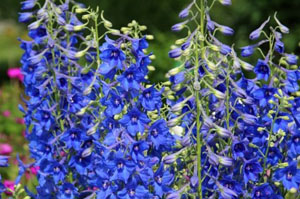Delphinium
 The name of this flower actually derives from the Latin for ‘dolphin’ (delphis). Its buds appear to resemble the aquatic mammals, and it is one of the most popular summer garden flowers available.
The name of this flower actually derives from the Latin for ‘dolphin’ (delphis). Its buds appear to resemble the aquatic mammals, and it is one of the most popular summer garden flowers available.
Description
The flowers of the delphinium are often brightly coloured and stand out in any garden. They bloom in bright blues, purples and crisp whites primarily, but they can also be found in yellow and salmon pink.
Habitat
The flowers’ willow pattern colour range can help identify its natural habitat. It is native to China, but it can now also be found across the world in places like California.
Availability
The prime period of flowering for the delphinium is throughout June and July and it is best to separate the plants in the spring months of March and April. While there are some that are available all year, flowering is actually quite short-lived for the delphinium.
Species
Species of the delphinium bloom in all three primary colours, but hybrids have introduced an abundance of other colourful additions to the garden. In total, there are believed to be around 300 species of the delphinium.
Care Tips
The delphinium is a poisonous flower so make sure to wash all trace of it off after you have handled it. Try not to move delphiniums after they have been planted and keep the soil as deep, moist and rich as you can.
Did you know?
- The delphinium and larkspur make good dried flowers, so make sure you don’t always dispose of them if you want extended use out of them.
- The delphinium bakeri and delphinium luteum, found in restricted parts of California, are believed to be highly endangered species of the genus.
References
http://www.bbc.co.uk/gardening/plants/plant_finder/plant_pages/8947.shtml
http://www.mrsgreenfingers.co.uk/how-to-grow-delphiniums.html
http://www.mrsgreenfingers.co.uk/how-to-grow-delphiniums.html


